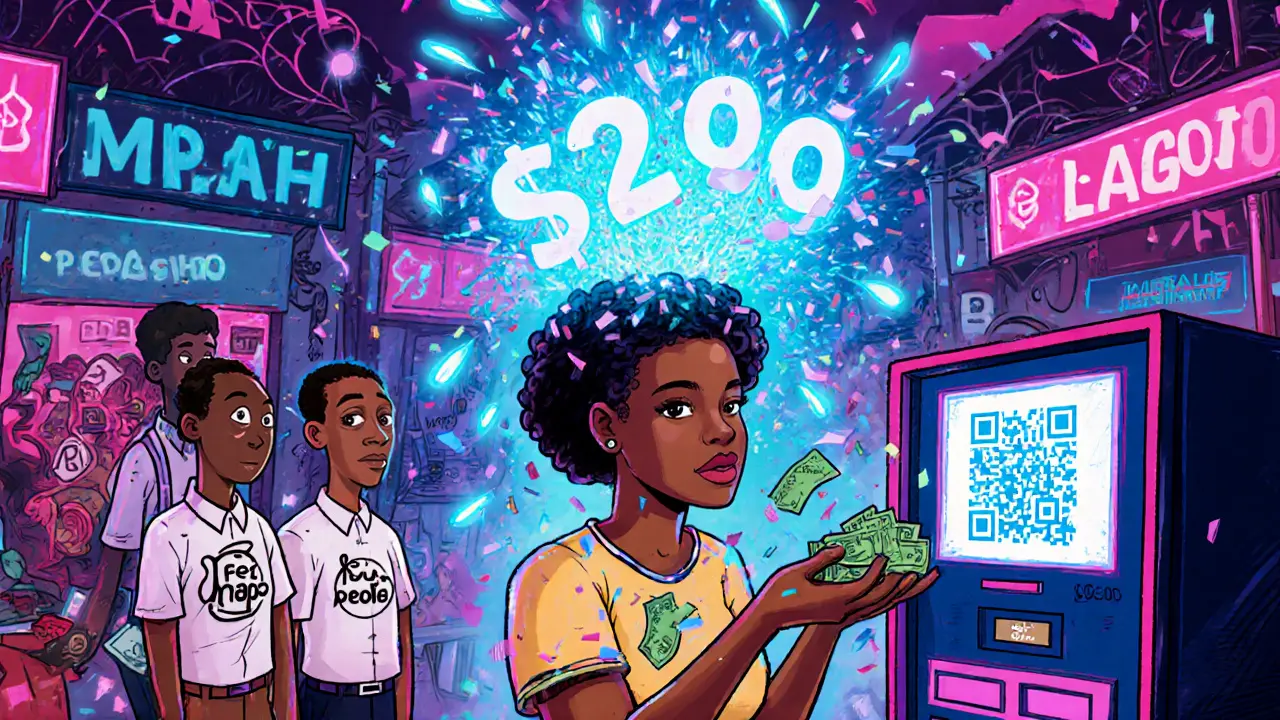How Cryptocurrency and Stablecoins Are Changing Cross-Border Remittances
Remittance Cost Calculator
Send Money
How It Works
Traditional remittances cost 6.62% on average. Stablecoin transfers cost under $0.01 for the transfer, plus 2-5% cash-out fee.
Estimated savings:
You could save 62.3% with stablecoin transfers
Cost Breakdown
Traditional Method
Fees: $13.24
Total cost: $213.24
Stablecoin Transfer
Network Fee: $0.01
Cash-Out Fee: $5.00
Total cost: $205.01
Every year, migrant workers send over $200 billion to their families back home. For many, that money is rent, food, school fees, or medical care. But sending it often costs more than it should. The average fee to send $200 across borders is still 6.62%-that’s over $13 in fees just to get cash into a loved one’s hands. Traditional banks, Western Union, and MoneyGram charge high fees, drag out the process for days, and hide extra costs in bad exchange rates. Meanwhile, a quieter revolution is happening: people are turning to cryptocurrency, especially stablecoins, to move money faster, cheaper, and more directly.
Why Traditional Remittances Are Still Too Expensive
The old system doesn’t move money-it moves messages. When you send $200 from the U.S. to Nigeria, your bank doesn’t wire cash. It sends a message to its correspondent bank in London, which sends another message to a bank in Lagos, which finally credits the recipient’s account. Each step adds time, complexity, and cost. Five or six intermediaries might touch that transaction. Each one takes a cut. The World Bank says the global average fee is 6.62%. In some corridors-like the U.S. to Latin America or South Asia-it’s even higher.And it’s not just about the fee. Delays are common. Transfers can take 2-5 business days. If the recipient doesn’t have a bank account, they might need to travel miles to pick up cash. If the exchange rate is bad, they get less than expected. For families living paycheck to paycheck, that’s not just inconvenience-it’s hardship.
How Stablecoins Cut Costs and Speed Up Payments
Stablecoins are digital tokens backed 1:1 by real money-like the U.S. dollar. USDC and USDT are the most common. Unlike Bitcoin, they don’t swing wildly in value. That makes them ideal for sending real money across borders.Here’s how it works: You send $200 worth of USDC from your crypto wallet to your sister’s wallet in Mexico. The transaction hits the blockchain-usually Ethereum or Solana-and settles in under a minute. Fees? Often less than a penny. No middlemen. No hidden exchange rates. She gets the full $200 in digital form.
In 2024, stablecoins moved $15.6 trillion in value-roughly equal to Visa’s entire annual transaction volume. By early 2025, they handled 3% of all global cross-border payments. That’s $6 trillion in remittances alone. And it’s growing fast. The Philippines saw cryptocurrency remittances jump 217% in 2024. Nigeria, Kenya, and Vietnam are following.
The Real Advantage: No Intermediaries, Just Code
Traditional payments rely on a chain of banks that trust each other. Blockchain removes that. Instead of messages passing between institutions, a single transaction updates accounts on a public ledger. Smart contracts automate the process. When you send USDC, the blockchain verifies the sender has the funds, checks compliance rules, and transfers the token-all in seconds.One manufacturing company in Texas used to pay its suppliers in Singapore through wire transfers. Each payment took 3-5 days and cost $25-$40 in fees. After switching to USDC via a blockchain payment provider, payments now clear in 12 minutes. Fees? Under $0.05. They saved over $18,000 in a year.
This isn’t just for businesses. It’s for people. A mother in California sends $100 a week to her parents in the Philippines using a mobile app that converts dollars to USDC and sends it to their digital wallet. They cash out via a local agent who accepts USDC and gives them pesos. The whole process takes 15 minutes. The fee? 1.2%.

But It’s Not Perfect-Here’s Where It Still Falls Short
The biggest problem? Access. Many recipients don’t have crypto wallets. They don’t know how to use them. Or worse-they can receive USDC but can’t easily turn it into cash without paying another fee.A Reddit user in Nigeria shared: “My brother sends me USDC every month. I use a local exchange to convert it to naira, but they charge 4%. That wipes out half the savings.”
That’s the catch. If the final leg-the cash-out-is expensive, the whole advantage vanishes. That’s why platforms like Yellow Card and BVNK are building on-ramps: partnerships with local cash agents, mobile money providers, and ATMs that let people convert crypto to fiat instantly.
Another issue? Regulation. The U.S. is still figuring out how to treat stablecoins. The EU has MiCA, a clear set of rules. India bans crypto payments. Brazil allows them but with heavy reporting. If you’re a business using stablecoins for payroll or supplier payments, you need to comply with AML and KYC rules in every country you operate in. That’s complicated.
Who’s Winning-and Who’s Getting Left Behind
Traditional players aren’t sitting still. Wise and Western Union are testing blockchain. But they’re still stuck in old models. Wise charges 1.5% to send $200 to India. A stablecoin transaction? Less than $0.10. But Wise has branches, ATMs, and trust. Stablecoin providers don’t yet.The real winners are the startups building bridges: Circle (USDC), Ripple (XRP for banks), and newer players like BVNK and BitPesa. They’re not just moving crypto-they’re connecting crypto to cash. BVNK’s platform lets companies send USDC to suppliers in 60+ countries. The supplier gets paid in local currency automatically. No wallet needed on their end.
But adoption is uneven. Southeast Asia and Africa lead because traditional systems there are expensive and unreliable. In Europe and North America, people are slower to switch. Why? They have banks. They have credit cards. They don’t feel the pain enough.

What’s Next? CBDCs and the Global Payment Puzzle
Governments are watching. Over 90 central banks are testing digital currencies-called CBDCs. China’s digital yuan, the ECB’s digital euro, and the Fed’s pilot projects are all steps toward a future where money moves like data: instantly, globally, and with built-in rules.The Bank for International Settlements is already testing mBridge-a blockchain-based system that lets central banks settle cross-border payments in seconds. It’s not crypto. It’s not stablecoins. But it’s the same idea: remove intermediaries, automate trust, and settle in real time.
Experts agree: blockchain won’t replace banks overnight. But it will force them to change. The question isn’t whether crypto will win. It’s whether legacy systems can adapt fast enough.
How to Start Using Cryptocurrency for Remittances
If you want to try it:- Use a trusted platform like Circle, Coinbase, or BVNK that supports USDC.
- Buy USDC with your bank account or debit card.
- Send it to the recipient’s wallet address (they’ll need to sign up for a wallet app like MetaMask or Trust Wallet).
- Have them cash out through a local partner-like a mobile money agent, crypto ATM, or exchange that offers peso, naira, or peso payouts.
For businesses: Partner with a licensed provider that offers auto-conversion to local currency, reconciliation tools, and compliance support. Training takes 2-3 weeks. But the savings? Often 70% or more on transaction costs.
Final Reality Check
Cryptocurrency isn’t magic. It doesn’t fix bad regulation. It doesn’t solve poverty. But it does fix one thing: the broken cost structure of global money transfers. For the first time, sending money across borders can cost less than a coffee. For millions of families, that’s not a tech trend-it’s a lifeline.The future isn’t about replacing banks. It’s about giving people more control. More speed. More transparency. And less wasted money.
Can I send cryptocurrency to someone who doesn’t have a crypto wallet?
Yes, but only if the recipient uses a service that converts crypto to cash automatically. Platforms like Yellow Card, BVNK, and Paxful partner with local cash agents in countries like Nigeria, Philippines, and Mexico. The sender sends USDC. The recipient gets cash at a nearby store or mobile money kiosk-no wallet needed. The conversion happens behind the scenes.
Is it legal to use cryptocurrency for remittances?
It depends on the country. In the U.S., Canada, EU, and Japan, using stablecoins for remittances is legal as long as you use licensed providers and follow AML/KYC rules. In countries like China, India, and Egypt, crypto payments are restricted or banned. Always check local laws. Some countries allow crypto ownership but prohibit using it to pay for goods or services-including remittances.
Are stablecoin transactions really cheaper than banks?
Yes, by a huge margin. Traditional remittances average 6.62% in fees. On Layer 2 blockchains like Polygon or Solana, stablecoin transfers cost under $0.01. Even on Ethereum, fees rarely exceed $0.50. That’s 99% cheaper. The only added cost is the cash-out fee, which can be 2-5% if the recipient uses a third-party exchange. But even then, the total cost is still far lower than Western Union or Wise.
How fast do stablecoin remittances actually settle?
Under a minute. Most stablecoin transfers on modern blockchains settle in 10-60 seconds. Compare that to traditional wire transfers, which can take 2-5 business days. Even fast services like Wise take 1-2 days. Blockchain doesn’t wait for bank hours or holidays. It runs 24/7.
What’s the biggest risk of using crypto for remittances?
The biggest risk is losing access to your wallet. If you forget your private key or send crypto to the wrong address, there’s no customer service to reverse it. Also, if the recipient uses an unregulated exchange to cash out, they could lose money to scams. Always use licensed, audited platforms. Never send crypto to someone you don’t know. And always double-check wallet addresses before sending.
Will stablecoins replace banks for remittances?
Not completely-not yet. Banks still hold deposits, manage risk, and comply with complex regulations. But they’re being forced to adapt. Many are now integrating blockchain tech behind the scenes. The real shift is toward hybrid systems: banks use crypto rails for settlement, but customers still interact through familiar apps. In 5 years, you might not even know you’re using blockchain-you’ll just see faster, cheaper transfers.
LaTanya Orr
November 20, 2025 AT 19:36It’s not about crypto. It’s about dignity.
Ashley Finlert
November 22, 2025 AT 15:33This is not innovation. This is restitution.
Chris Popovec
November 23, 2025 AT 12:37Don’t be fooled.
Marilyn Manriquez
November 24, 2025 AT 09:02taliyah trice
November 25, 2025 AT 22:23Charan Kumar
November 27, 2025 AT 20:12Peter Mendola
November 28, 2025 AT 11:55Terry Watson
November 30, 2025 AT 09:40It could. And it is.
Sunita Garasiya
December 1, 2025 AT 21:05Mike Stadelmayer
December 2, 2025 AT 15:05Norm Waldon
December 3, 2025 AT 18:20neil stevenson
December 5, 2025 AT 11:45That’s the future. Simple.
Samantha bambi
December 6, 2025 AT 02:58Anthony Demarco
December 6, 2025 AT 20:22Just leave me alone.
Lynn S
December 7, 2025 AT 18:59Jack Richter
December 8, 2025 AT 13:53sky 168
December 10, 2025 AT 01:24